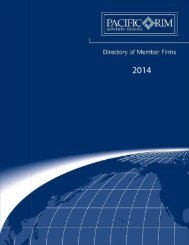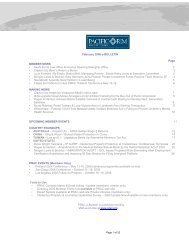A Guide to the Law of Securitisation in Australia - Clayton Utz
A Guide to the Law of Securitisation in Australia - Clayton Utz
A Guide to the Law of Securitisation in Australia - Clayton Utz
- No tags were found...
Create successful ePaper yourself
Turn your PDF publications into a flip-book with our unique Google optimized e-Paper software.
An <strong>in</strong>terest <strong>in</strong> a managed <strong>in</strong>vestment scheme clearly is def<strong>in</strong>edvery widely. If <strong>the</strong>re were no limitations on <strong>the</strong> concept, it wouldembrace any type <strong>of</strong> <strong>in</strong>vestment contemplated <strong>in</strong> <strong>the</strong> bus<strong>in</strong>esscommunity. Therefore, <strong>in</strong> order <strong>to</strong> make <strong>the</strong> def<strong>in</strong>ition, and <strong>the</strong>associated regula<strong>to</strong>ry scheme, workable, <strong>the</strong> Corporations Acthas had <strong>to</strong> specify a number <strong>of</strong> exclusions. These <strong>in</strong>clude <strong>the</strong>issue <strong>of</strong> debentures by a body corporate.The purpose <strong>of</strong> exclud<strong>in</strong>g debentures is <strong>to</strong> ensure that <strong>the</strong>y areregulated only by Chapter 2L <strong>of</strong> <strong>the</strong> Corporations Act (see above)and not also by <strong>the</strong> managed <strong>in</strong>vestment scheme sections.There is a real prospect that a structured <strong>in</strong>strument that is not adebenture will qualify as an <strong>in</strong>terest <strong>in</strong> a managed <strong>in</strong>vestmentscheme. This follows from two fac<strong>to</strong>rs: first, from <strong>the</strong> width <strong>of</strong><strong>the</strong> def<strong>in</strong>ition itself; secondly, <strong>the</strong> body <strong>of</strong> case law confirm<strong>in</strong>gthat a debt security issued <strong>to</strong> <strong>in</strong>ves<strong>to</strong>rs <strong>in</strong> circumstances where<strong>the</strong> money is <strong>the</strong>n re<strong>in</strong>vested and <strong>in</strong>ves<strong>to</strong>rs are promised acerta<strong>in</strong> rate <strong>of</strong> <strong>in</strong>terest, and repayment <strong>of</strong> pr<strong>in</strong>cipal, satisfies <strong>the</strong>def<strong>in</strong>ition <strong>of</strong> a managed <strong>in</strong>vestment scheme.Interest<strong>in</strong>gly, bills <strong>of</strong> exchange and promissory notes are nolonger specifically excluded from <strong>the</strong> def<strong>in</strong>ition <strong>of</strong> managed<strong>in</strong>vestment scheme, as was <strong>the</strong> case <strong>in</strong> respect <strong>of</strong> <strong>the</strong> def<strong>in</strong>ition<strong>of</strong> participation <strong>in</strong>terest under <strong>the</strong> former regime. For some <strong>of</strong> <strong>the</strong>implications <strong>of</strong> this, see section 2.2.5.The statu<strong>to</strong>ry requirements for <strong>in</strong>terests <strong>in</strong> a managed <strong>in</strong>vestmentschemeChapter 5C <strong>of</strong> <strong>the</strong> Corporations Act regulates <strong>the</strong> issue <strong>of</strong><strong>in</strong>terests <strong>in</strong> managed <strong>in</strong>vestment schemes. Every registeredmanaged <strong>in</strong>vestment scheme must have a responsible entity,be<strong>in</strong>g <strong>the</strong> person who operates <strong>the</strong> scheme and performs <strong>the</strong>functions which are conferred upon it by <strong>the</strong> scheme’sconstitution and <strong>the</strong> Corporations Act. The Chapter sets out <strong>the</strong>statu<strong>to</strong>ry responsibilities <strong>of</strong> a responsible entity and its <strong>of</strong>ficers<strong>to</strong> <strong>the</strong> members <strong>of</strong> <strong>the</strong> scheme. It also provides for <strong>the</strong>registration with <strong>the</strong> <strong>Australia</strong>n Securities and InvestmentsCommission (ASIC) <strong>of</strong> <strong>the</strong> govern<strong>in</strong>g constitution <strong>of</strong> <strong>the</strong> managed<strong>in</strong>vestment scheme and its compliance plan, which must conta<strong>in</strong><strong>the</strong> measures taken, or <strong>to</strong> be taken, by <strong>the</strong> responsible entity <strong>to</strong>ensure compliance with its constitution and <strong>the</strong> Corporations Act.2.2.3 The extent <strong>to</strong> which securitisations <strong>in</strong>volve debenturesand <strong>in</strong>terests <strong>in</strong> a managed <strong>in</strong>vestment schemeAs can be seen from <strong>the</strong> above, some securitised <strong>in</strong>strumentsmay be debentures, o<strong>the</strong>rs may be <strong>in</strong>terests <strong>in</strong> a managed<strong>in</strong>vestment scheme, while o<strong>the</strong>rs may be nei<strong>the</strong>r. <strong>Securitisation</strong>sbased on <strong>the</strong>se different <strong>in</strong>struments might be regulated underChapter 2L, Chapter 5C or may be completely unregulated.However, <strong>in</strong> order <strong>to</strong> simplify <strong>the</strong> analysis <strong>in</strong> this publication, it isassumed that a debt security issued by a corporation is adebenture, but it is important <strong>to</strong> appreciate that this may <strong>of</strong>tennot be <strong>the</strong> case.It is clear that equity securities issued by a trustee (ie. units <strong>in</strong> aunit trust) are <strong>in</strong>terests <strong>in</strong> a managed <strong>in</strong>vestment scheme (eg. seeAt<strong>to</strong>rney General <strong>of</strong> NSW v <strong>Australia</strong>n Fixed Trusts [1947] ACLC40-100), which was decided under <strong>the</strong> previous regime, but <strong>the</strong>reason<strong>in</strong>g <strong>of</strong> which cont<strong>in</strong>ues <strong>to</strong> apply <strong>to</strong> <strong>the</strong> current def<strong>in</strong>ition <strong>of</strong>a managed <strong>in</strong>vestment scheme.As can be seen from <strong>the</strong> above, bills <strong>of</strong> exchange (for anyamount) and promissory notes (for a face value <strong>in</strong> excess <strong>of</strong>$50,000) are not debentures. Therefore, securitisations based on<strong>the</strong>se are not regulated by Chapter 2L. However, securitisationsbased on bills <strong>of</strong> exchange or promissory notes have <strong>the</strong> potential<strong>to</strong> be regulated under Chapter 5C as managed <strong>in</strong>vestmentschemes.A more difficult issue is <strong>the</strong> proper classification <strong>of</strong> debtsecurities issued by trustees. On <strong>the</strong>ir face, <strong>the</strong>y should beregulated <strong>in</strong> <strong>the</strong> same manner as for o<strong>the</strong>r debt securities (ie. on<strong>the</strong> basis that <strong>the</strong>y are debentures). This approach, however, iscomplicated by a draft Policy Statement issued <strong>in</strong> July 1992 by<strong>the</strong> <strong>Australia</strong>n Securities Commission (ASC), <strong>the</strong> predecessor <strong>to</strong>ASIC. In it <strong>the</strong> ASC felt that debt securities issued by trustees <strong>in</strong>securitisations were not debentures and should be regulated by ahybrid approach blend<strong>in</strong>g <strong>the</strong> <strong>the</strong>n Divisions 4 and 5, which nowcorrespond <strong>to</strong> Chapters 2L and 5C.In most cases, <strong>the</strong> proper classification <strong>of</strong> a securitised<strong>in</strong>strument as a debenture, or an <strong>in</strong>terest <strong>in</strong> a managed<strong>in</strong>vestment scheme, has no immediate commercial ramifications.This is because <strong>the</strong> regula<strong>to</strong>ry regimes imposed by Chapters 2Land 5C do not apply where <strong>the</strong>re is an <strong>of</strong>fer <strong>of</strong> securities thatdoes not need disclosure under Chapter 6D.2. As will be seenfrom <strong>the</strong> next section, <strong>the</strong> effect <strong>of</strong> this is that almost <strong>the</strong> entiresecuritisation <strong>in</strong>dustry is exempt from <strong>the</strong> application <strong>of</strong> <strong>the</strong>seChapters <strong>of</strong> <strong>the</strong> Corporations Act. The only exception is that allissues <strong>of</strong> debentures need <strong>to</strong> comply with <strong>the</strong> register provisions<strong>of</strong> <strong>the</strong> Corporations Act (sections 168(1)(c) and 171). However,<strong>the</strong>se are not onerous and can be easily satisfied.Recently however, <strong>the</strong>re have been a number <strong>of</strong> “retail”securitisation issues. In <strong>the</strong>se cases it is important <strong>to</strong> determ<strong>in</strong>e<strong>the</strong> proper classification <strong>of</strong> <strong>the</strong> securities as debentures, <strong>in</strong>terests<strong>in</strong> a managed <strong>in</strong>vestment scheme or nei<strong>the</strong>r. As can be seen from<strong>the</strong> previous analysis, some arbitrary results can arise.11






